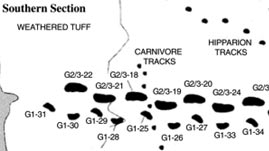Thank goodness for the irrepressible urge of humans (and other animals) to joke and play around in nearly any situation. Sometimes, it pays big dividends. It certainly did in 1976, when paleoanthropologist Andrew Hill and a colleague were tossing elephant dung at each other in Laetoli, a hominid archeological site in Tanzania. As Hill dived out of the way, he stumbled on what turned out to be one of the wonders of prehistoric finds: a trail of hominid footprints about 3.6 million years old.
The majority of the Laetoli footprint site was excavated in 1978. Until then, the oldest known footprints of human ancestors were tens of thousands of years old. But this trail, some 80 feet long and preserved in cementlike volcanic ash, had been made by some of the first upright-walking hominids. An almost unimaginable sequence of events preserved what paleontologist Ian Tattersall calls a fossil of human behavior -- prehistoric walking.
Initially, a nearby volcano called Sadiman erupted a cloud of fine ash, like beach sand, that left a layer on the landscape. Then a light rain fell onto the ash to create something like wet cement -- an ideal material for trapping footprints. Birds and mammals left a great number of prints, but, spectacularly, so did a pair of hominids, one large and one small, trekking across the ash. (Some analysts conclude that it is possible to detect the trail of a third, smaller individual whose tracks overlap the footprints left by one of the others.) A subsequent eruption from Sadiman dropped more ash, sealing the footprints like a laminated driver's license. Finally, erosion over millions of years unveiled the prints for Hill and other researchers in Mary Leakey's group to discover.
The prints, say experts on hominid body structure, are strikingly different from those of a chimpanzee, and in fact are hardly distinguishable from those of modern humans. The only known hominid fossils of that age in that location are those of Lucy and her kind, the small-brained but upright-walking hominids classified as
Australopithecus afarensis. Some analysts have noted that the smaller of the two clearest trails bears telltale signs that suggest whoever left the prints was burdened on one side -- perhaps a female carrying an infant on her hip. While the detailed interpretation of the prints remains a matter of debate, they remain an extraordinary and fascinating fossil find, preserving a moment in prehistoric time.

 Loading Standards
Loading Standards Teachers' Domain is proud to be a Pathways portal to the National Science Digital Library.
Teachers' Domain is proud to be a Pathways portal to the National Science Digital Library.
